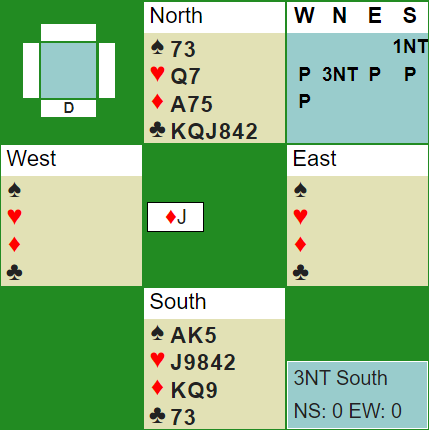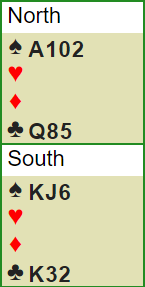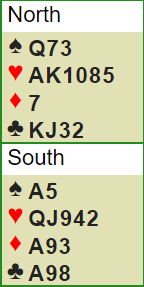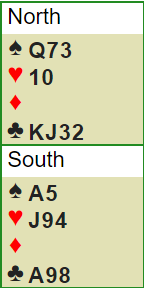AuthorI remember well how my great friend and mentor, José Dulphe Pinheiro Machado, defined the difference between the good player and the great player. According to him, "The good player manages the suits competently, while the great player manages the suits taking into account the entire hand". In other words, the good player plays to make as many tricks as possible, while the great player has the bigger goal -- making the contract -- in mind. The following hands illustrate the difference. They are simple hands, all from actual play. The best play is within anyone's reach, as long as they follow the expert's advice: to play the hand keeping in mind the final goal... making the contract. This is the first hand: The good player would win the trick in his hand and play a club to one of dummy's honors. After winning the trick, he would continue with a second club honor from the board. If this second club trick lost to the Ace while the other defender discarded, the good player would shake his had, mutter "bad luck, all I needed was a 3-2 club split." The great player would think along these lines: "I have 3 tricks in diamonds and 2 tricks in spades. All I need from clubs are 4 tricks. Therefore, I can afford the safety play of ducking the first trick in clubs, which will ensure the contract if the suit breaks 4-1." After ducking the 1st club trick, he can win any return in hand, play another club to one of dummy's honors, and the Queen of diamonds is the sure entry for the bulk of the club suit. Of course, if the lead had been a spade, all would be changed. With a single stopper in the suit the defense is attacking, declarer would have to plan for losing the hand only once, i.e., he would have to play for clubs to break 3-2. And this is the difference. The great player adapts his line of play according to the opening lead, since the right play in any suit is always related to the larger picture of the entire hand. Another example: You are playing 4 Spades after the Queen of hearts lead. The good player would observe one loser in diamonds and 2 almost certain losers in clubs. He would win the lead in dummy with the Ace and cash the spade Ace and King, hoping to draw trumps without losers. His chance of succeeding is approximately 52%. Who could accuse him of misplaying the hand? Declarer would have handled the trumps correctly, since with nine cards in both hands missing the Queen, the best play, all else being equal, is to cash the two top honors. The great player would answer: "Yes, that is true, looking at the spade suit in isolation. But the entire hand suggests a better line, requiring only that the lead of the Queen of hearts was made with length in that suit (rather than shortness). This proposition is surely a better chance than 52%." He would have eliminated the side suits, without drawing any trumps. Win the lead, play the Queen of diamonds. The opponents will probably win and play another heart. (If the Queen of diamonds wins the trick, you should play King of hearts and a heart ruff immediately, and then play another diamond from your hand). After winning the 2nd heart honor in dummy, you ruff a heart in your hand; play the King of diamonds, and ruff a diamond; and play the 4th heart from dummy. If West discards, you ruff and reach this ending: Now you drive out the Ace of clubs, win the club return, and play your 3rd club. If East followed to the 4th heart (meaning, you will be overruffed if East has the Queen of trumps), you pitch a club loser, and revert to the original chance of capturing the opponent's Queen of trumps by direct trump leads. Of course, by playing the hand in this fashion, you run some risks of early ruffs/overruffs, but the chance of West having 4 or 5 hearts surely is big enough to balance this risk. And the last exhibit: You received the lead of the King of diamonds against your contract of Six Hearts. The good player would reason like this: "There are two different ways of winning the hand. I can draw trumps and play Ace of spades and a spade. If the King of spades is onside, I will pitch a club. If it is offside, I can try the club finesse later. Or, I can draw trumps, cash the King and Ace of clubs, and lead a club to the Jack. I will only lose the hand if East has Q10xx or Q10xxx in clubs, giving me something like an 80% shot." The great player would answer: "These are good lines of play, but if trumps break 2-1, there is a better line. As usual, he would not be looking at individual suits, but rather at the entire hand. The right line is to eliminate diamonds while drawing trumps, reaching this position, having to play from dummy: Now you should play a club from dummy to your Eight! West will be endplayed and can only play a spade, any other suit being an admission of defeat. You are not playing the club suit for best advantage, but you are adding the chance of West having the King of spades, increasing significantly the odds of making your contract. In fact, you will lose only if West has precisely 10x or Q10xx (or singleton 10 -- but wouldn't he have led a club then, at least in some cases?) in clubs and no King of spades.
Your chances in clubs are in the vicinity of 83% (even if we allow full weight for the possibility of a singleton 10). The finesse in spades elevates your total toe low 90's. clearly the best shot for the contract, looking at the entire hand rather than an isolated suit.
0 Comments
Leave a Reply. |
Archives
September 2021
Categories
All
|





 RSS Feed
RSS Feed